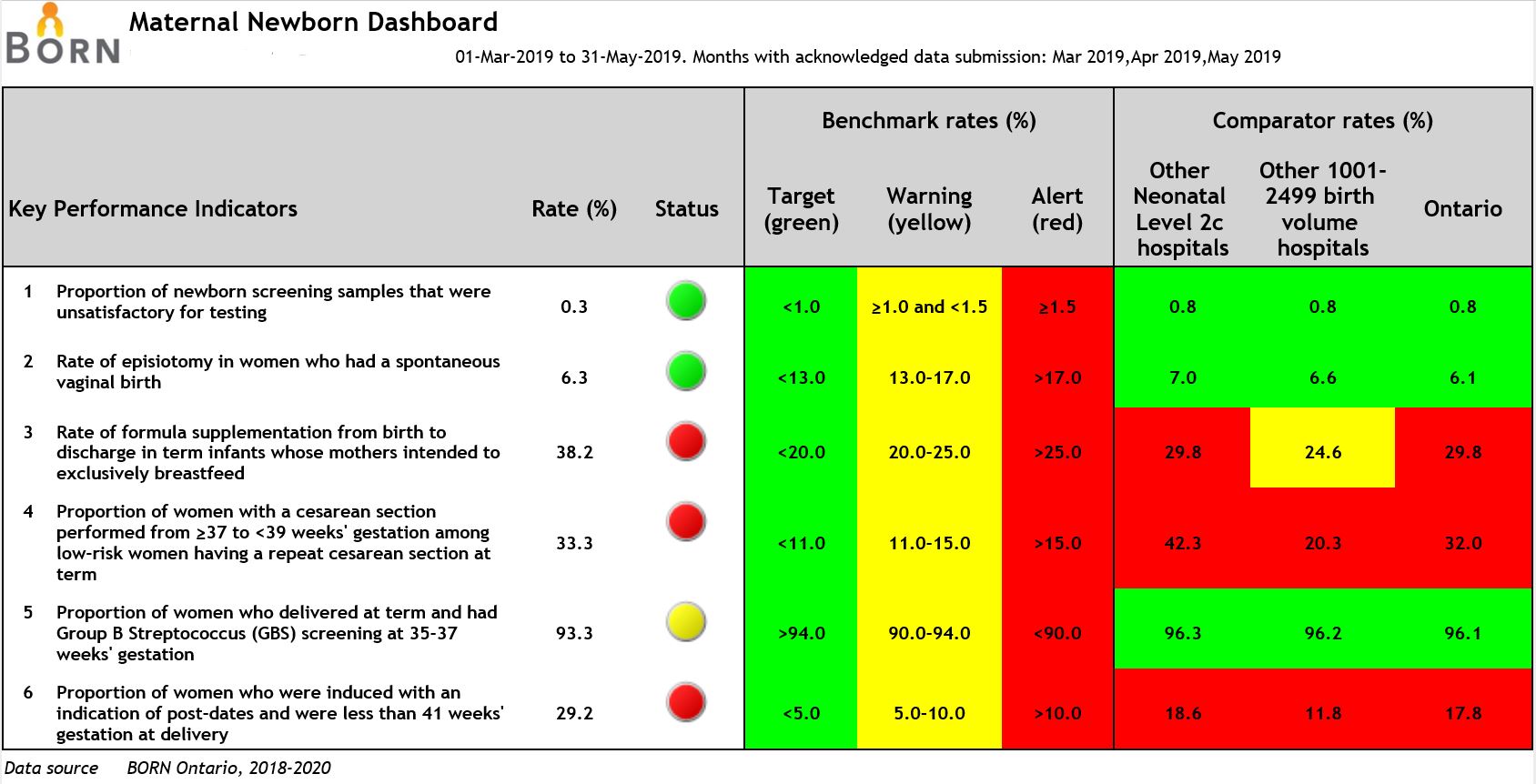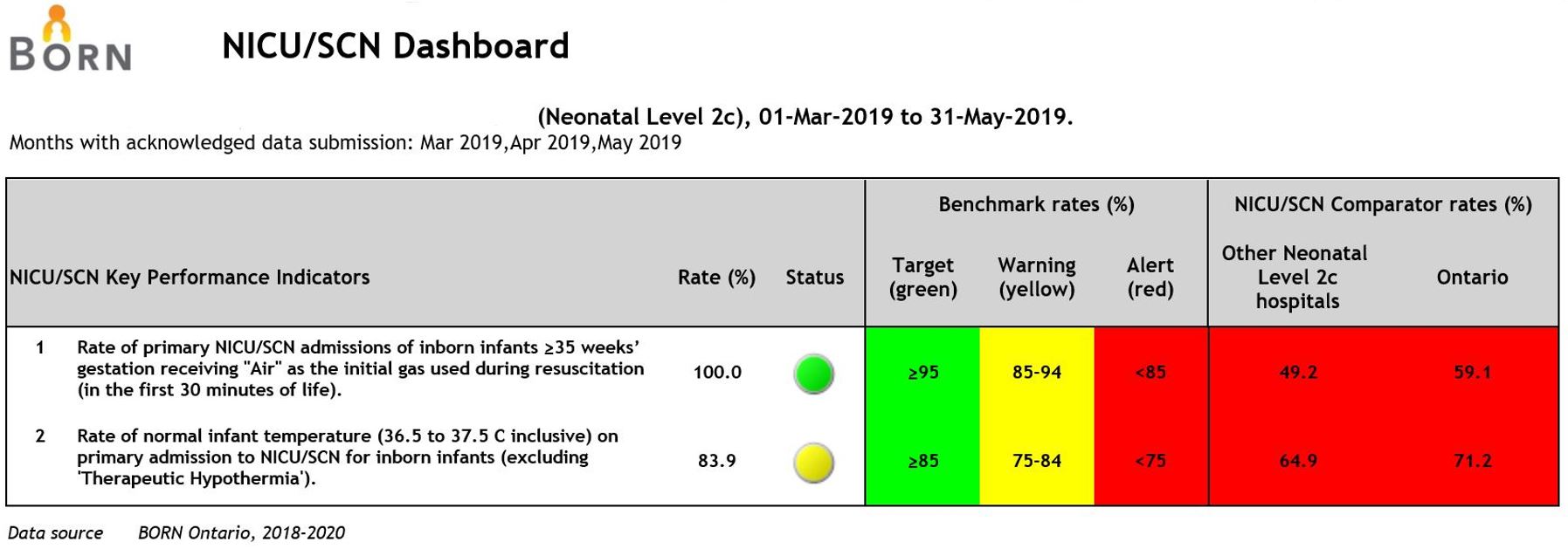Monitoring and Evaluating Quality Care
With data on over one million babies and their mothers, BORN Ontario is well-positioned to:
- monitor trends in maternal-newborn care and outcomes over time; and
- evaluate the effect of new health care technologies, interventions, and programs.
Below are examples of how BORN Ontario has contributed to monitoring and evaluating quality care, ensuring maternal-newborn care in Ontario is safe, effective, timely, efficient, equitable, and people-centered.1
The Maternal Newborn Dashboard: an audit and feedback system for Ontario maternal-newborn hospitals |
|
“Audit and feedback” can be used by health care providers and hospitals to determine whether their current practice is aligned with evidence based standards or if there is need for improvement. The Maternal Newborn Dashboard, developed and launched by BORN Ontario in 2012, is an electronic audit and feedback system that all maternal-newborn hospitals in Ontario can access. The Dashboard shows hospitals their rates on six important clinical practices (called Key Performance Indicators, KPIs) and alerts hospitals with a red/yellow signal when best practice is not being met. An evaluation of the Maternal Newborn Dashboard using BORN data showed that the system helped hospitals to significantly improve on four out of the six indicators, meaning that for every 100 individuals there were: 11.7 fewer inductions done for “post-dates” for pregnant individuals less than 41 weeks at delivery. 10.4 fewer elective repeat caesarean sections done on low risk individuals less than 39 weeks at delivery. This reduction translates to a significant cost savings.2 2.8 more individuals received group B streptococcus (GBS) screening at the right time during pregnancy. 1.5 fewer episiotomies were done.3 This information shows that using the Dashboard can help to trigger clinical practice improvement in maternal-newborn settings that prioritize these issues, and develop tailored strategies for change.4 While the MND reports on maternal-newborn practice, BORN also recently launched a dashboard and key performance indicators for NICUs across the province. |
The Ontario Birth Centre Demonstration Project: evaluating the first year of operations |
|
In 2012, the Ontario Ministry of Health and Long-term Care announced funding for two new free-standing midwifery-led birth centres. In 2014, the two new centres opened in Ottawa and Toronto, allowing individuals in midwifery care to choose between home, hospital, or birth centre for place of birth. The opening of the birth centres was an important opportunity to learn about the implementation process and clinical outcomes of this new model in Ontario. An evaluation of the first year of operations of the two new Ontario birth centres using BORN data found that: Compared to midwifery clients giving birth in a hospital, midwifery clients who chose to give birth at a birth centre had significantly less interventions, even when controlled for their body mass index (BMI) and previous caesarean birth. The care provided by midwives in the birth centres was in alignment with current best practice recommendations. Delivering at an Ontario birth centre was safe for this population, with low rates of poor maternal and newborn outcomes.5 |
Integrating cell-free DNA (cfDNA) screening for aneuploidy into the prenatal screening system in Ontario |
|
Cell-free DNA (cfDNA) screening (or non-invasive prenatal testing) is a maternal blood test that can be taken after 9-10 weeks' gestation to test for conditions such as Down syndrome. This new screening technology became available in Ontario in 2012 and was the best screening technology to detect conditions such as Down syndrome, but at a higher cost than the currently used screening technologies. In 2014, the Ontario Ministry of Health and Long-Term care began using a “modified contingent” model of funding for cfDNA screening, which means that pregnant individuals at higher risk of certain conditions can have their cfDNA screening publicly funded. After the implementation of publicly funded cfDNA screening in Ontario, an evaluation was conducted using BORN data to learn about the effect of this new funding model. Results of this evaluation demonstrated: The availability of public funding for cfDNA screening resulted in a significant increase in uptake of cfDNA screening.6 After implementation of funded cfDNA screening, significantly fewer individuals had invasive prenatal diagnostic testing.6 The uptake of cfDNA varied by geographical location, with the lowest rates in northwest Ontario and the highest rates in urban centres. Health care providers who order the cfDNA screening do not always follow the eligibility criteria for public funding. This evaluation demonstrates that since the Ontario Ministry of Health and Long-Term Care started funding cfDNA screening for some pregnant individuals, screening uptake overall has increased, and the rate of invasive diagnostic testing has decreased. There needs to be further work to explore the cost effectiveness of the modified contingent model, to improve health care provider adherence to funding guidelines, and to understand geographical differences in use. |
Evaluation of the Electronic Healthy Babies Healthy Children (eHBHC) screen in Ontario |
|
In 2016, an electronic version of the postnatal Healthy Babies Healthy Children (eHBHC) screening tool was added to the BORN Information System. This screen is offered at or before discharge to all individuals giving birth in a hospital, entered into the BORN Information System, and subsequently transferred to the Integrated Services for Children Information System (ISCIS) which is used by Ontario Public Health Units. The electronic transfer of this HBHC screening data from birthing hospitals to Public Health Units facilitates faster follow-up by public health with families identified as “with risk.” After the pilot implementation of eHBHC in 2016 and a larger provincial roll-out in 2018-2019, BORN Ontario conducted an evaluation to examine data usage and quality, and explore user experiences. A key finding from this evaluation was related to the number and distribution of missed eHBHC screens, for example: There was variability across hospitals, with some hospitals having a higher proportion of missed postpartum eHBHC screens compared to other hospitals. There was a marked difference in the proportion of first-time mothers (i.e., primipara) who were not offered a postpartum eHBHC screen compared to individuals who have previously had a child (i.e., multipara). These results have informed the development of a subsequent evaluation to begin investigating what factors (e.g., hospital factors, clinical factors, eHBHC procedural factors) are associated with missing eHBHC screens in Ontario. Understanding why eHBHC screens are missed can be used to improve staff training and awareness to ensure missing eHBHC screens are reduced and/or eliminated. Ensuring all individuals are offered the eHBHC screen will ultimately increase the timely identification of families and children at risk of negative developmental outcomes and the provision of appropriate postnatal and early childhood follow-up services. |
World Health Organization. What is Quality of Care and why is it important? . Accessed June 5, 2019.
Longo CJ, Harrold J, Dunn S, Smith G. Elective repeat caesarean section in low-risk women—economic evaluation comparing births before vs. after 39 weeks gestation in Ontario, Canada. Journal of Obstetrics and Gynaecology Canada. 2018;40(12):1600-1607. doi: 10.1016/j.jogc.2018.04.010
Weiss D, Dunn SI, Sprague AE, Fell DB, Grimshaw JM, Darling E, Graham D, Harrold J, Smith GN, Peterson WE, Reszel J, Lanes A, Walker MC, Taljaard M. Effect of a population-level performance dashboard intervention on maternal-newborn outcomes: an interrupted time series study. BMJ Quality and Safety. 2018;27(6):425-436. doi: 10.1136/bmjqa2017-007361.
Reszel J, Dunn S, Sprague AE, Graham ID, Grimshaw JM, Peterson WE, Ockenden H, Wilding J, Quosdorf A, Darling EK, Fell DB, Harrold J, Lanes A, Smith GN, Taljaard M, Weiss D, Walker MC. Use of a maternal newborn audit and feedback system in Ontario: A collective case study. BMJ Quality & Safety. 2019. doi:10.1136/bmjqs-2018-008354. [epub ahead of print]
Sprague AE, Sidney D, Darling EK, Van Wagner V, Soderstrom B, Rogers J, Graves E, Coyle D, Sumner A, Holmberg V, Khan B, Walker MC. Outcomes for the first year of Ontario's Birth Center Demonstration Project. Journal of Midwifery & Women's Health. 2018; 63(5):532-540. doi: 10.1111/jmwh.12884
Huang T, Dougan S, Walker M, Armour C, Okun N. Trends in the use of prenatal testing services for fetal aneuploidy in Ontario: a descriptive study. CMAJ Open. 2018;6(4):E436-E444.





 Subscribe to this page
Subscribe to this page
